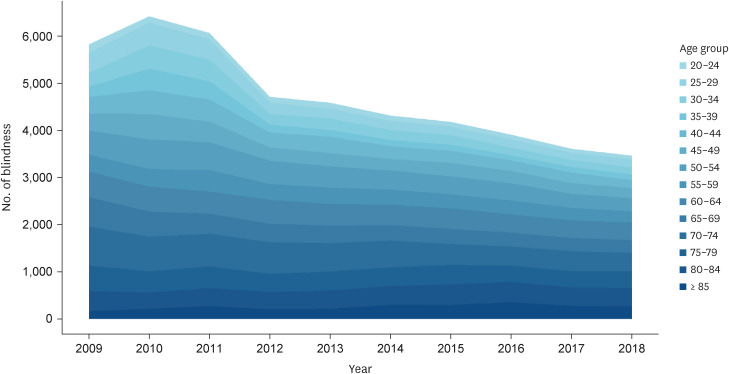J Korean Med Sci.
2023 Jul;38(28):e213. 10.3346/jkms.2023.38.e213.
Trends in the Prevalence of Blindness and Correlation With Health Status in Korean Adults: A 10-Year Nationwide Population-Based Study
- Affiliations
-
- 1Department of Ophthalmology, Kangdong Sacred Heart Hospital, Hallym University College of Medicine, Seoul, Korea
- 2Department of Ophthalmology, Hanyang University Seoul Hospital, Hanyang University College of Medicine, Seoul, Korea
- 3Department of Ophthalmology, Seoul National University Hospital, Seoul National University College of Medicine, Seoul, Korea
- KMID: 2544474
- DOI: http://doi.org/10.3346/jkms.2023.38.e213
Abstract
- Background
Contemporary data on vision impairment form an important basis for public health policies. However, most data on the clinical epidemiology of blindness are limited by small sample sizes and focused not on systemic conditions but ophthalmic diseases only. In this study, we examined the ten-year trends of blindness prevalence and its correlation with systemic health status in Korean adults.
Methods
This study investigated 10,000,000 participants randomly extracted from the entire Korean population (aged ≥ 20 years) who underwent a National Health Insurance Service health checkup between 2009 and 2018. Participants with blindness, defined as visual acuity in the better-seeing eye of ≤ 20/200, were identified. The prevalence of blindness was assessed, and the systemic health status was compared between participants with blindness and without blindness.
Results
The mean prevalence of blindness was 0.473% (47,115 blindness cases) and tended to decrease over ten years (0.586% in 2009 and 0.348% in 2018; P < 0.001). The following factors were significantly associated with blindness: female sex, underweight (body mass index < 18.5), high serum creatinine (> 1.5 mg/dL), and bilateral hearing loss. In addition, except for those aged 30–39 and 40–49 years, high fasting glucose (≥ 126 mg/dL) and low hemoglobin (male: < 12 g/dL, female: < 10 g/dL) were significantly correlated with prevalent blindness.
Conclusion
Our ten-year Korean nationwide population-based study suggested a gradual decrease in the prevalence of blindness and its association with specific systemic health status. These conditions might be the cause or consequence of blindness and can be used as a reference for the prevention and/or rehabilitation of blindness to establish public health policies.
Keyword
Figure
Reference
-
1. Chuvarayan Y, Finger RP, Köberlein-Neu J. Economic burden of blindness and visual impairment in Germany from a societal perspective: a cost-of-illness study. Eur J Health Econ. 2020; 21(1):115–127. PMID: 31493181.2. Köberlein J, Beifus K, Schaffert C, Finger RP. The economic burden of visual impairment and blindness: a systematic review. BMJ Open. 2013; 3(11):e003471.3. Jacobs JM, Hammerman-Rozenberg R, Maaravi Y, Cohen A, Stessman J. The impact of visual impairment on health, function and mortality. Aging Clin Exp Res. 2005; 17(4):281–286. PMID: 16285193.4. Klein BE, Moss SE, Klein R, Lee KE, Cruickshanks KJ. Associations of visual function with physical outcomes and limitations 5 years later in an older population: the Beaver Dam eye study. Ophthalmology. 2003; 110(4):644–650. PMID: 12689880.5. Swanson MW, McGwin G. Visual impairment and functional status from the 1995 National Health Interview Survey on Disability. Ophthalmic Epidemiol. 2004; 11(3):227–239. PMID: 15370554.6. Pascolini D, Mariotti SP. Global estimates of visual impairment: 2010. Br J Ophthalmol. 2012; 96(5):614–618. PMID: 22133988.7. Iwase A, Araie M, Tomidokoro A, Yamamoto T, Shimizu H, Kitazawa Y, et al. Prevalence and causes of low vision and blindness in a Japanese adult population: the Tajimi Study. Ophthalmology. 2006; 113(8):1354–1362. PMID: 16877074.8. Xu L, Wang Y, Li Y, Wang Y, Cui T, Li J, et al. Causes of blindness and visual impairment in urban and rural areas in Beijing: the Beijing Eye Study. Ophthalmology. 2006; 113(7):1134.e1–1134.11.9. Gunnlaugsdottir E, Arnarsson A, Jonasson F. Prevalence and causes of visual impairment and blindness in Icelanders aged 50 years and older: the Reykjavik Eye Study. Acta Ophthalmol. 2008; 86(7):778–785. PMID: 18513265.10. Limburg H, Barria von-Bischhoffshausen F, Gomez P, Silva JC, Foster A. Review of recent surveys on blindness and visual impairment in Latin America. Br J Ophthalmol. 2008; 92(3):315–319. PMID: 18211928.11. Tang Y, Wang X, Wang J, Huang W, Gao Y, Luo Y, et al. Prevalence and causes of visual impairment in a Chinese adult population: the Taizhou Eye Study. Ophthalmology. 2015; 122(7):1480–1488. PMID: 25986897.12. Flaxman SR, Bourne RR, Resnikoff S, Ackland P, Braithwaite T, Cicinelli MV, et al. Global causes of blindness and distance vision impairment 1990-2020: a systematic review and meta-analysis. Lancet Glob Health. 2017; 5(12):e1221–e1234. PMID: 29032195.13. Hyman L, Wu SY, Connell AM, Schachat A, Nemesure B, Hennis A, et al. Prevalence and causes of visual impairment in the Barbados Eye Study. Ophthalmology. 2001; 108(10):1751–1756. PMID: 11581045.14. Zheng Y, Lavanya R, Wu R, Wong WL, Wang JJ, Mitchell P, et al. Prevalence and causes of visual impairment and blindness in an urban Indian population: the Singapore Indian Eye Study. Ophthalmology. 2011; 118(9):1798–1804. PMID: 21621261.15. Liang YB, Friedman DS, Wong TY, Zhan SY, Sun LP, Wang JJ, et al. Prevalence and causes of low vision and blindness in a rural Chinese adult population: the Handan Eye Study. Ophthalmology. 2008; 115(11):1965–1972. PMID: 18684506.16. Wong TY, Mitchell P. The eye in hypertension. Lancet. 2007; 369(9559):425–435. PMID: 17276782.17. Cheng Q, Saaddine JB, Klein R, Rothenberg R, Chou CF, Il’yasova D. Early age-related macular degeneration with cardiovascular and renal comorbidities: an analysis of the National Health and Nutrition Examination Survey, 2005-2008. Ophthalmic Epidemiol. 2017; 24(6):413–419. PMID: 28891729.18. Sasongko MB, Widyaputri F, Agni AN, Wardhana FS, Kotha S, Gupta P, et al. Prevalence of diabetic retinopathy and blindness in Indonesian adults with type 2 diabetes. Am J Ophthalmol. 2017; 181:79–87. PMID: 28669781.19. Varma R, Wu J, Chong K, Azen SP, Hays RD. Los Angeles Latino Eye Study Group. Impact of severity and bilaterality of visual impairment on health-related quality of life. Ophthalmology. 2006; 113(10):1846–1853. PMID: 16889831.20. Song SO, Jung CH, Song YD, Park CY, Kwon HS, Cha BS, et al. Background and data configuration process of a nationwide population-based study using the Korean National Health Insurance system. Diabetes Metab J. 2014; 38(5):395–403. PMID: 25349827.21. Kim YH, Han K, Son JW, Lee SS, Oh SW, Kwon HS, et al. data analytic process of a nationwide population-based study on obesity using the National Health Information Database presented by the National Health Insurance Service 2006-2015. J Obes Metab Syndr. 2017; 26(1):23–27. PMID: 31089490.22. Ministry of Health and Welfare (KR). The Health Screening Implementation Standards (Notification No. 2020-313). Sejong, Korea: Ministry of Health and Welfare;2020.23. Ministry of Health and Welfare (KR). Table 4. Criteria for determining diagnoses based on the results of general health screening. The Health Screening Implementation Standards (Notification No. 2020-313). Sejong, Korea: Ministry of Health and Welfare;2020.24. Vitale S, Cotch MF, Sperduto RD. Prevalence of visual impairment in the United States. JAMA. 2006; 295(18):2158–2163. PMID: 16684986.25. Robinson B, Feng Y, Woods CA, Fonn D, Gold D, Gordon K. Prevalence of visual impairment and uncorrected refractive error - report from a Canadian urban population-based study. Ophthalmic Epidemiol. 2013; 20(3):123–130. PMID: 23713914.26. Dandona R, Dandona L. Refractive error blindness. Bull World Health Organ. 2001; 79(3):237–243. PMID: 11285669.27. World Health Organization (WHO) Programme for the Prevention of Blindness and Deafness. Consultation on Development of Standards for Characterization of Vision Loss and Visual Functioning: Geneva, 4–5 September 2003. Geneva, Switzerland: World Health Organization;2003.28. World Health Organization. World Report on Vision. Geneva, Switzerland: World Health Organization;2019.29. Cui Y, Zhang L, Zhang M, Yang X, Zhang L, Kuang J, et al. Prevalence and causes of low vision and blindness in a Chinese population with type 2 diabetes: the Dongguan Eye Study. Sci Rep. 2017; 7(1):11195. PMID: 28894238.30. Kim KE, Kim MJ, Park KH, Jeoung JW, Kim SH, Kim CY, et al. Prevalence, awareness, and risk factors of primary open-angle glaucoma: Korea National Health and Nutrition Examination Survey 2008-2011. Ophthalmology. 2016; 123(3):532–541. PMID: 26746594.31. Cheung N, Wong TY. Obesity and eye diseases. Surv Ophthalmol. 2007; 52(2):180–195. PMID: 17355856.32. Newman-Casey PA, Talwar N, Nan B, Musch DC, Stein JD. The relationship between components of metabolic syndrome and open-angle glaucoma. Ophthalmology. 2011; 118(7):1318–1326. PMID: 21481477.33. Kuper H, Polack S, Eusebio C, Mathenge W, Wadud Z, Foster A. A case-control study to assess the relationship between poverty and visual impairment from cataract in Kenya, the Philippines, and Bangladesh. PLoS Med. 2008; 5(12):e244. PMID: 19090614.34. Mojon-Azzi SM, Sousa-Poza A, Mojon DS. Impact of low vision on employment. Ophthalmologica. 2010; 224(6):381–388. PMID: 20606492.35. American Diabetes Association. (2) Classification and diagnosis of diabetes. Diabetes Care. 2015; 38(Suppl):S8–16.36. Nangia V, Jonas JB, Matin A, Bhojwani K, Sinha A, Kulkarni M, et al. Prevalence and associated factors of glaucoma in rural central India. The Central India Eye and Medical Study. PLoS One. 2013; 8(9):e76434. PMID: 24098790.37. Bahar A, Kashi Z, Ahmadzadeh Amiri A, Nabipour M. Association between diabetic retinopathy and hemoglobin level. Caspian J Intern Med. 2013; 4(4):759–762. PMID: 24294469.38. Clyne N, Jogestrand T, Lins LE, Pehrsson SK. Progressive decline in renal function induces a gradual decrease in total hemoglobin and exercise capacity. Nephron J. 1994; 67(3):322–326.39. Park SJ, Lee JH, Woo SJ, Ahn J, Shin JP, Song SJ, et al. Age-related macular degeneration: prevalence and risk factors from Korean National Health and Nutrition Examination Survey, 2008 through 2011. Ophthalmology. 2014; 121(9):1756–1765. PMID: 24813632.40. Shim SH, Sung KC, Kim JM, Lee MY, Won YS, Kim JH, et al. Association between renal function and open-angle glaucoma: the Korea National Health and Nutrition Examination Survey 2010-2011. Ophthalmology. 2016; 123(9):1981–1988. PMID: 27432204.41. Gopinath B, Rochtchina E, Wang JJ, Schneider J, Leeder SR, Mitchell P. Prevalence of age-related hearing loss in older adults: Blue Mountains Study. Arch Intern Med. 2009; 169(4):415–416. PMID: 19237727.42. Gopinath B, Schneider J, McMahon CM, Teber E, Leeder SR, Mitchell P. Severity of age-related hearing loss is associated with impaired activities of daily living. Age Ageing. 2012; 41(2):195–200. PMID: 22130560.43. Abou-Elhamd KA, ElToukhy HM, Al-Wadaani FA. Syndromes of hearing loss associated with visual loss. Eur Arch Otorhinolaryngol. 2014; 271(4):635–646. PMID: 23632871.44. Papadopoulos TA, Naxakis SS, Charalabopoulou M, Vathylakis I, Goumas PD, Gartaganis SP. Exfoliation syndrome related to sensorineural hearing loss. Clin Exp Ophthalmol. 2010; 38(5):456–461. PMID: 20649615.45. Cahill M, Early A, Stack S, Blayney AW, Eustace P. Pseudoexfoliation and sensorineural hearing loss. Eye (Lond). 2002; 16(3):261–266. PMID: 12032714.46. Shin YU, Park SH, Chung JH, Lee SH, Cho H. Diabetic retinopathy and hearing loss: results from the Fifth Korean National Health and Nutrition Survey. J Clin Med. 2021; 10(11):2398. PMID: 34071684.47. Caban AJ, Lee DJ, Gómez-Marín O, Lam BL, Zheng DD. Prevalence of concurrent hearing and visual impairment in US adults: the National Health Interview Survey, 1997-2002. Am J Public Health. 2005; 95(11):1940–1942. PMID: 16195516.48. Yamada Y, Vlachova M, Richter T, Finne-Soveri H, Gindin J, van der Roest H, et al. Prevalence and correlates of hearing and visual impairments in European nursing homes: results from the SHELTER study. J Am Med Dir Assoc. 2014; 15(10):738–743. PMID: 24984787.49. Lam BL, Lee DJ, Gómez-Marín O, Zheng DD, Caban AJ. Concurrent visual and hearing impairment and risk of mortality: the National Health Interview Survey. Arch Ophthalmol. 2006; 124(1):95–101. PMID: 16401790.50. Miyawaki A, Kobayashi Y, Kawachi I. Self-reported hearing/visual loss and mortality in middle-aged and older adults: findings from the Komo-Ise Cohort, Japan. J Epidemiol. 2020; 30(2):67–73. PMID: 30662042.
- Full Text Links
- Actions
-
Cited
- CITED
-
- Close
- Share
- Similar articles
-
- Ten-Year trends and prevalence of asthma, allergic rhinitis, and atopic dermatitis among the Korean population, 2008–2017
- Prevalence of Low Vision in 2017 Based on Korea National Health andNutritional Examination Survey
- Trends in Age-Specific Prevalence of Lower Urinary Tract Dysfunction: A Nationwide Population-Based Cohort Study
- Health Education for Prevention of Blindness in Health Delivery System
- Are We in the Same Risk of Diabetes Mellitus? Gender- and Age-Specific Epidemiology of Diabetes in 2001 to 2014 in the Korean Population




